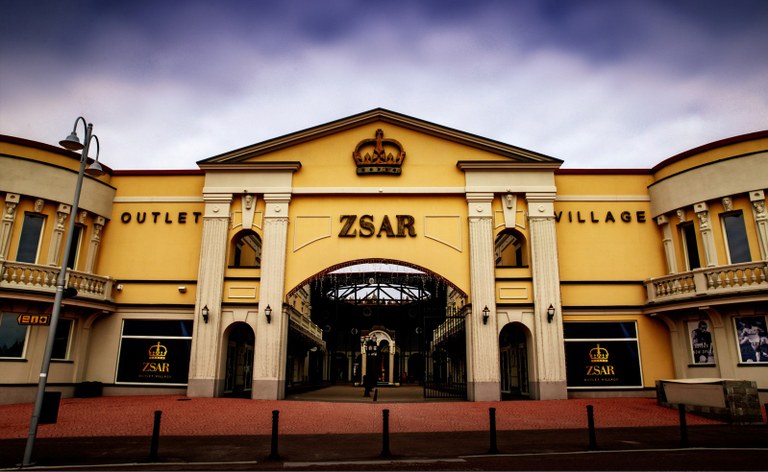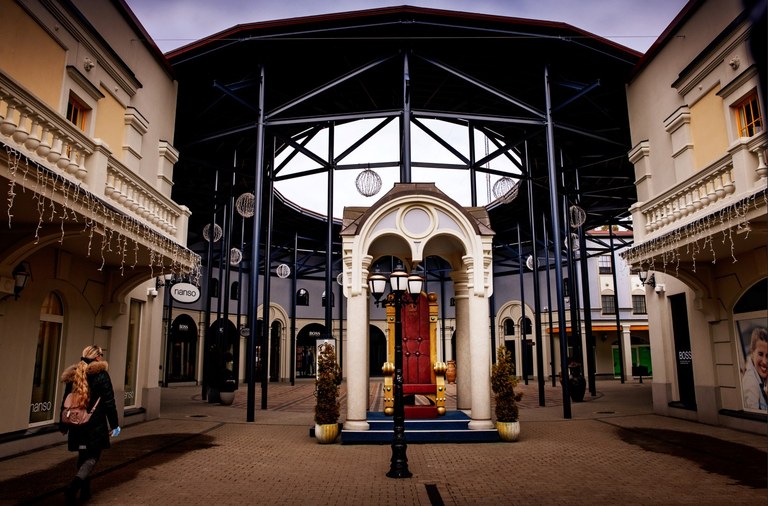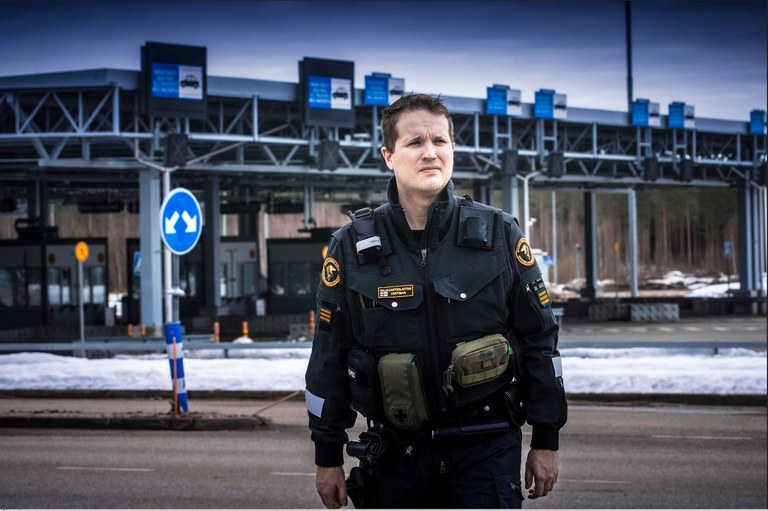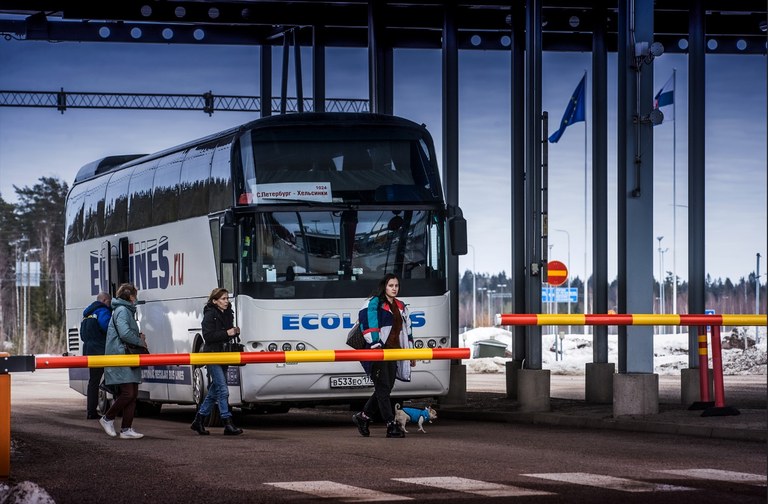Border trade crisis: Zsar's luxury fashion tempts neither Russians nor Finns in Vaalimaa
Some of the shops in Zsar Outlet Village are having closing down sales. Most offer 30 to 70% discounts on well-known brands meant to tempt Russian tourists to shop right next to the border crossing with Finland.
Many Finns have traditionally travelled to Russia to buy cheap petrol, vodka and groceries or to look at the deterioration of the old, former Finnish, city of Vyborg.
The Russians did the opposite when the Wall came down and it became easier to buy luxury goods in the West. For a long time, the Stockmann department stores had been the only providers of Western luxury and everyday goods in Russia. Later, the Russians wanted to travel themselves.

Zsar Outlet Village is a large shopping centre for luxury products.
The shopping tourists were looking for international products in a larger supply than what they could find in the new Russia. Finland watched in amazement as Russians, who previously had been considered not to have any money, arrived.
Expensive building for expensive products
In recent years, several new shopping centres have sprung up near the Vaalimaa border crossing, where the E18 national road will take you via the Russian border crossing Torfjanovka to Vyborg and St Petersburg. Russians keen to shop no longer have to travel all the way to Helsinki.
Zsar Outlet Village is the most spectacular of the shopping centres. It opened in time for the 2018 Christmas season. So far it has not seen much economic success, despite rising visiting numbers.
The inside of the shopping centre is bleak. Just half of the spaces have been rented lately. 32 shops out of a total of 60 were open during the winter. Some of the international brands have taken a break but will return if the border with Russia opens and travellers return.
There are rumours of bankruptcy or a complete shutdown. But the mother company has already been through a corporate reorganisation, an alternative to bankruptcy. This allows the centre to stay open.

There are not many customers in the exclusive shopping centre. Both the pandemic and the war in Ukraine have made it difficult to turn a profit.
The centre was shut for several months at the start of the pandemic. Later, it started targeting Finnish shoppers too, even though the shopping centre is remotely situated for anyone who is not on their way to cross the border. The war in Ukraine has also had consequences. Sanctions and price increases mean more trouble.
Strengthening border and customs controls
A few hundred metres from the shopping centre lies the border. Vaalimaa border crossing is an enormous complex comprising border checks, customs and Corona checks. The number of crossings has fallen sharply, due to other things besides the pandemic.
The Finnish Border Guard points to the fact that the security situation has become increasingly unpredictable. Military tensions in Ukraine bring challenges to safety in Finland’s neighbourhoods too. As a result, the Border Guard has increased its capacity.

"We maintain our readiness and always have done to be prepared for all eventualities," says Jani Westman.
The continuing security situation means Finland is about to join Nato. In its latest budget proposal, the Finnish government has added some 650 million euro to strengthen border control, cyber security, refugee handling and the protection of citizens. The fact that this will soon be Nato’s eastern border is not forgotten.
A fence against organised flow of refugees from the East?
There has also been talk of erecting a fence along the border. There is a fear of Russian interference after Finland’s decision to apply for Nato membership.
The opposition True Finns party have been heading warnings against an uncontrollable number of refugees coming across the border from Russia. The Finnish Border Guard points to what happened on the Polish and Baltics’ borders in November last year, when Belarus allowed refugees to cross.
“We maintain our readiness as we always have. We train for all possible scenarios,” says Jani Westman, the duty officer at Vaalimaa,
Things are calm at the official border crossings. Jane Westman indicates that it is calmer than usual.
“Before the pandemic, we had 10,000 border crossings every 24 hours. Now, 2,000 crossings constitute a busy day. There are fewer than 100 cars a day,” estimates Westman and says this is but a fraction of what it used to be.
The liveliest time comes around 11 am. Three different Russian coach services are travelling from St Petersburg to Helsinki and will return in the evening. A small number of private cars cross the border, which for now is only open during the day.

There is not much traffic at the Vaalimaa border crossing.
Freight is nearly completely gone, however. Articulated lorries and trucks with Russian or Belarusian number plates are no longer allowed to cross the border. A lot of goods is also blacklisted and cannot be taken into or out of Russia.
Grew up on the border
Jani Westman has guarded the border all of his life. He grew up near the border in Ilomantsi further north, and his father was also a border guard.
Westman has been working for the Border Guard for 19 years, mainly in Vaalimaa but he spent eight years at the Helsinki Vantaa Airport.
He studied Russian and visited the neighbouring country in his youth. But it is now ten years since he was last there, so Westman has no idea of the situation on the Russian side or how things near the border have changed.
He can not comment on the border crossings, including how many work there. This is operational information.
The passport union makes things easier on the borders between the five Nordic countries. Jani Westman says he sometimes goes on holiday to Norway or Sweden and appreciates the simplicity at the border. But he sees no chance of easing the strict border controls to the East. Having grown up next to a closed border, he is used to these things.
“At one time perhaps I believed we might be able to remove visas between Finland and Russia. But now the borders are hardly open. There has been talk about dropping visas for a long time, but it seems Russia wants things to stay the way they are.”
Jani Westman believes this is more a question for Russia than for the EU and Schengen countries.
- The Zsar's palace
-
The shopping centre's exterior is built in Russian style with facades echoing Russian state palaces in St Petersburg. A lone woman is cleaning the enormous parking area by hand. There is plenty of space and only a handful of cars are parked there.
 Follow us on Facebook
Follow us on Facebook
